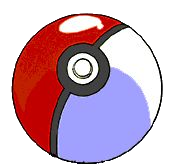- Note: For competitive battling, see the Competitive battling page.
Battling is a major part in Pokémon GS. Approximately 70% of your game time will be spent on battling wild Pokémon or different trainers. Learn how to put up a good fight by getting down the basics of battling.
The Basics[edit | edit source]
- Whenever a trainer spots you, he/she will challenge you to a battle.
- If a trainer does not spot you but you still want to battle, talk to them.
- When you are inside the tall grass, there is a chance that a wild Pokémon will attack you.
- When you are inside of a cave, a wild Pokémon may attack (even without grassy patches).
- Each Pokémon have a maximum of four moves, and a minimum of one move. No Pokémon will have zero or more than four.
- Gym Leaders will not challenge you on their own, you must talk to them to challenge them.
Hit and Power Points[edit | edit source]
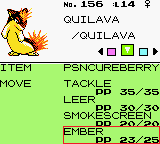
Your Pokémon's health is measured by its Hit Points, or HP. In battle, the damage your Pokémon takes will drain its HP. If its HP reaches zero, your Pokémon will faint and be out of commission until you treat it with a special item (like a Revive) or check it in a Pokémon Center. Power Points, or PP, measure your Pokémon's abilities. The number of times you can use an attack depends on how many PP you have for that move. Every time you use an attack, you will spend one PP. Replenish PP at a Pokémon Center or by using a Special item.
Status Conditions[edit | edit source]
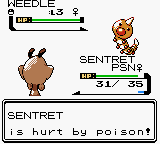
Most attacks take their toll on the victim's HP only. Other attacks are a little trickier and affect the targeted Pokémon's composure or inflict it with damage that lasts for the entire battle or until the effect is reversed. Those types of attacks are good to open with since they can help you soak your opponent's HP, while a poison attack can continue to harm your opponent while you spend subsequent turns unleashing other attacks on it. If your Pokémon falls victim to an attack with long-lasting side effects, give it immediate attention before your Pokémon faints. Some attacks like poison ones will continue to hurt your Pokémon until you cure it with a special item or take it to a Pokémon Center.
What the Conditions Mean[edit | edit source]
- Poison: You lose HP each turn in battle, and every 4 steps out of battle.
- Badly Poisoned: It is the same as Poison except its damage begins at 1/16 and grows an additional 1/16 every turn, taking 2/16 max Hit Points the second turn, then 3/16 the third turn, and 4/16 the fourth, and so on.
- Sleep: Cannot attack. Will wake up naturally in a few turns.
- Paralyze: Your skills fail 50% of the time, and speed is reduced by 75%.
- Burn: Lose HP each turn in battle, but not outside. Attack reduced.
- Freeze: Cannot attack. Will unfreeze if hit by Fire, or at end of battle.
- Confuse: Will attack self 50% of the time. Clears up when you switch Pokémon or at the end of battle.
- Infatuation: A Pokémon that is infatuated cannot attack 50% of the time, even against Pokémon other than the one it is infatuated with. Clears up when you switch Pokémon or at the end of battle.
- A Pokémon who is affected by a Status Problem can be cured in 2 ways.
- Going to the Pokémon Center will cure all status problems, plus healing your HP and PP to full. If there's a Pokémon Center nearby, go and heal your Pokémon. It's FREE!
- There are items who cure status problems. they will be listed on the Item section.
Learning from Experience[edit | edit source]
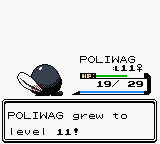
After every battle you send your Pokémon into, your Pokémon will gain Experience Points (even if you call it back before it gets a chance to fight) as long as it doesn't faint. As your Pokémon racks up Experience Points (EXP. Points), it will eventually mature to a new level. When Pokémon reach certain levels, they will automatically learn certain advanced moves. Enter all your Pokémon into as many battles as you can so they can develop new attacks and grow to new levels.
Wild Pokémon Battle[edit | edit source]

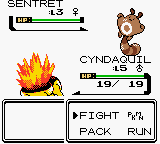
Whenever a battle starts, you will see the screen flashes and a small animation will occur over the screen.
This is a typical battle against a wild Sentret. In this screen, you can see the sprite of the Pokémon you're fighting, how many Pokémon you have (left), and the name of the Pokémon who appeared.
The main battle screen offers a bit more functions.
Fight[edit | edit source]
This is the main function at battling. It tells your Pokémon to use a Move. There are 3 general types of moves.
- Damaging Moves - These moves are intended purely to damage your opponent Pokémon. While there might be side effects from an attack, such a status changes or stat changes, damaging is the main idea here.
- Stat Modifying Moves - These moves are there to increase your stats. Or alternatively, make your opponent's stats decrease. Moves like Growl, Tail Wipe or Smokescreen will lower your opponent's stat by one level, while moves like Screech will make them go down by two levels.
- Status Problem Causing Moves - Status problems are as the name suggests, big problems. A list of status problems and their effects can be found above.
PKMN[edit | edit source]
This function serves one purpose: to switch Pokémon in the middle of battle. Of course you can also view summary etc. You cannot use HM moves of other Pokémon in battle, or Teleport or any other moves which have an effect outside of battle.
Pack (Items)[edit | edit source]
This function is used to use items while in battle. Not all items may be used inside a battle. (For example, Rare Candy or Bicycle may not be used, while Berries and Status Healers may be used). See Items for more details.
Run[edit | edit source]
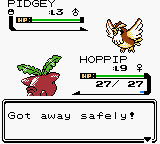
This functions works only with Wild Pokémon. When pressing this, you will make an attempt to run. How successful attempt? That varies with your Speed stat, the wild Pokémon Speed stat, and the level difference. If it works, you will run away and continue as if you have won the battle. If you fail to run, it will waste your turn.
Trainer Battle[edit | edit source]
A Trainer battle is very similar to a wild Pokémon battle. The only difference is that you may not run away, and you might fight multiple Pokémon in a row. If you have enabled it in the Options, you will be asked if you want to replace Pokémon before fighting the next Pokémon.
Another difference is that all Poké Balls are 0% effective. Even the Master Ball. DO NOT TRY IT OR YOUR BALL WILL BE LOST, which is a real shame in the case of the Master Ball, which is unique per game. By all other means, a Trainer battle and a wild Pokémon battle are exactly the same.
Also, after a Trainer battle ends, you will receive or lose money based on the result (you receive money if you win, and lose money if you lose).
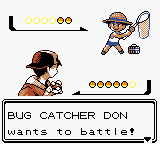
Combo Moves[edit | edit source]
There are a few moves that affect other moves, Schoolboy Jack tells you about these, here are a few:
- Defense Curl doubles Rollout's attack
- Rain makes Thunder 100% accurate and weakens fire
- Sunlight makes Solarbeam a 1 move attack
- Power of Thunder is doubled if the enemy uses fly on that turn
- Power of Gust is doubled if the enemy uses fly on that turn
- Power of Earthquake is doubled if the enemy uses Dig on that turn
- Power of Magnitude is doubled if the enemy uses Dig on that turn
- Lucky Strikes will occur more often if the Pokémon has almost no accuracy due to moves like sand attack
- Quick Claw combined with Quick attack makes the Pokémon attack first 100% even though both Pokémon use Quick attack on that turn and your Pokémon(with the quick claw) speed rating is lower
- Dragon Rage deals 40 damage - a fixed damage move no critical hits
- Sonic boom deals 20 damage - a fixed damage move no critical hits
- Use morning sun in the early day time, use moonlight in the middle of the night, use synthesis in the early afternoon
- Endure allows the user to retain 1HP on that turn to delay, but that endure does not count to the Poison/Burn effect following the attack, and will still faint the Pokémon if the effect is a killer move
- Swift hits the enemy even if the enemy uses fly on that turn. Misses if the enemy uses dig
- Rapid spin releases a Pokémon from enemy's bind, wrap, firespin, whirlpool or similar attack
- When both use fly on the same turn, the one who lands first misses the attack, and gets struck by the one who lands later
- Damage of Stomp is doubled if the enemy uses Minimize. Damage increases with each minimize used. However the problem is the accuracy
- Not all critical hit multipliers are x2. There are damages seen to be too ridiculous to be 2x the actual damage. It seems that those times are x2.5,x3,x3.5 or even x4. A lucky break, it happens in all versions
- Very useful battle tactic to use against ghost types: 1st use foresight/odour sleuth, then use Hyperbeam or any other normal type attack. The normal attack hits the ghost type.
